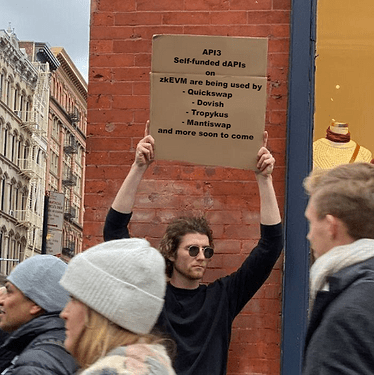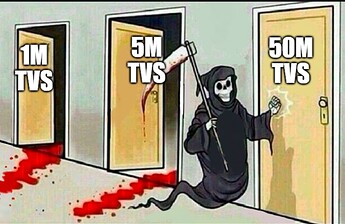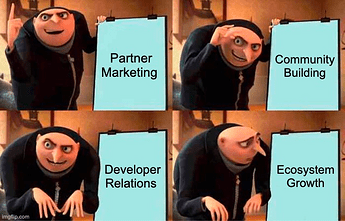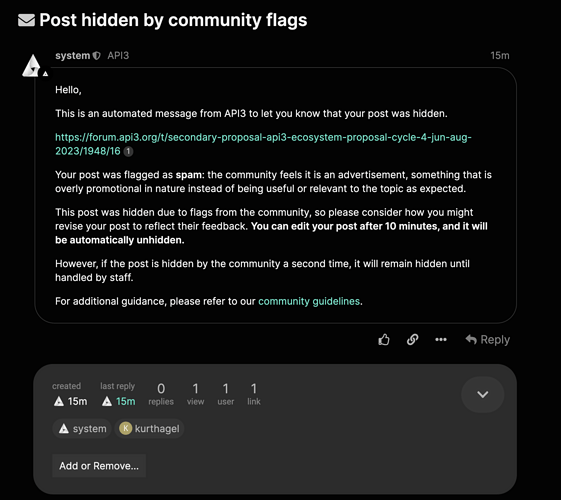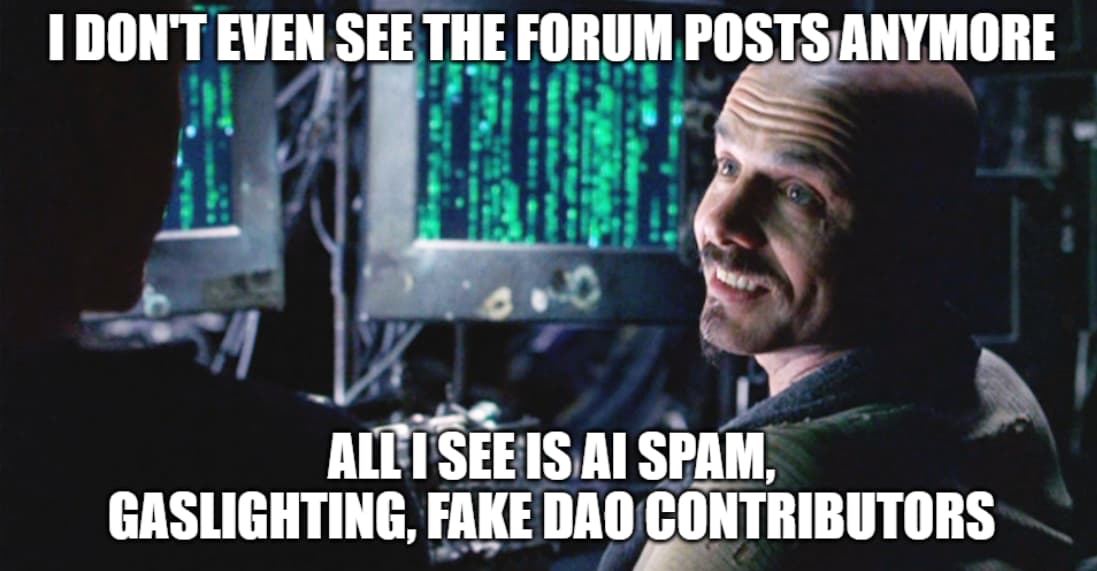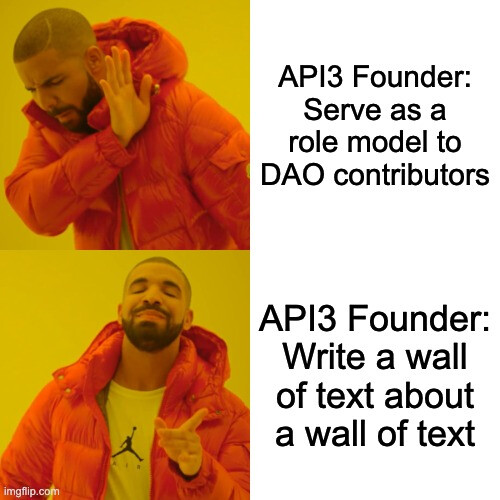Destination: Gnosis Safe (Multi-sig Wallet)
0x387f372284adab1b3E4f3bb1098aD060Aa5C4ADD
Signers:
Ben - 0x579D7a028634b9d95f3382AC2A20C9F5Bcc99976
Ashar - 0xf57B7C0025444c069dBfE12417729f22A13a399b
Vansh - 0xbAE697Bc7433E214eECf2816E5D74f2C6FCb4484
Hello everyone, this proposal is going to be a little different from the usual format and tone and I’d like to start off with a bit of history for the new members who are going to be joining the proposal.
To give some context for those who aren’t familiar with who I am, I’ve been a part of API3 for about 2 years now. Initially, I was part of the core technical team where I helped in writing and reviewing some of the earlier protocol contracts. Fast forward two years and I have been bouncing around teams, working on different aspects of the DAO ranging from QRNG, OEV , dAPIs, and airnode. I have also been actively involved in developer advocacy and business development efforts in this time frame. While I don’t claim to be an expert in any one of these areas I do think that has allowed me to bridge the gap of understanding between the technical,non-technical members of the DAO.
Ben on the other hand was initially part of the Marketing Proposal and was focused on partner marketing, but realized that bettering the developer experience was crucial given our target audience. He was one of the earliest members within the DAO that approached me in regards to bettering developer advocacy efforts. Noticing a lack of focus on developer-related activities, he made the decision to spin off a new proposal that would deliver this, as well as consider how we align with chain partners on developer activities. This is how the ecosystem proposal came to be.

Vansh was initially part of the Integrations team for well over a year and decided to move over to the ecosystem team because of his experience and expertise in both airnode and interacting with clients that use airnode. This made him the ideal person to write tutorials and guides on how to use and interact with airnode from the perspective of a user. He has been instrumental in delivering developer content across chain partners and I don’t think we would have the outreach we currently have without his efforts.
With a team in place, we set out to solve the problem that was outlined by Ben in the first ecosystem proposal. I think we have taken major strides by developing essential content for developers, organizing informative workshops, and working closely with our chain partners to get this message to the right people. However, there is still ample work to be done as we continue to strive towards our goals, particulary in unlocking the cyclical growth effect from user/community engagement into demand generation.
Seeing the growth of API3 in these two years from just being a vision that aims to solve the “Oracle problem” to it being actualized and taking shape has been quite the journey. In the process, we also found new and innovative solutions to problems like OEV (courtesy of dogebull) and showed how easy it can be to have a randomness source across multiple chains via QRNG. Finally, the promise of dAPIs isn’t far and self-funded feeds on zkEVM have already proven the robustness and reliability of airnode as an oracle node, kudos to the dAPI & UX team for their continuous and tireless efforts.
I would like to express my appreciation to the Business Development team, with whom I have been closely collaborating on the integration of dAPPS to use self-funded dAPIs. Their efforts have been instrumental in converting the relationships we have established with dAPPs on chains such as Polygon zkEVM and Arbitrum to API3 data feed users.
Self-funded and the road to managed dAPIs
Last cycle, we launched self-funded dAPIs with all our chain partners. The ecosystem team saw an opportunity to raise awareness about these dAPIs and used our relationships with our partners to do so. In particular, self-funded dAPIs have been widely adopted in Polygon zkEVM’s ecosystem. We will continue to work with their DeFi team to ensure that every dApp that requires an oracle can easily access it through Adapters, a backup oracle setup, or by reading it directly through the proxy.
With a growing TVS that continues to go up with every new dAPP we are working on solutions to make sure that these dAPPs can migrate to managed feeds without any friction. As such we will be shifting our focus towards working more closely with chain partners to ensure that the dAPPs on their chain have access to critical oracle infrastructure at all times.
Developer Experience
One of the goals of the last cycle was to make sure we have dAPI tutorials in all partner docs. Courtesy of vansh we are now currently featured in:
We are also working with zkSync and optimism to be included in their docs at a future date.
In addition to the above, we also supported QRNG users on Arbitrum before the launch of dAPIs by helping them integrate with Quintessence’s QRNG airnode on Arbitrum Nova and mainnet.
Creating feedback loops is generally a good starting point if looking to improve an experience. We generally need to bolster community efforts with an emphasis on developers and building in feedback mechanics would be a value add. Additionally, we look at feedback opportunities in the docs and drive accordingly.
We’ve been working on bounty processes for a while now, and we got to test them out at the EthZurich hackathon where we offered a $2k prize for the winner. We learned a lot from that experience and we’re ready to take our efforts to future hackathons like EthPrague and EthGlobal. The Ecosystem team has set up a gnosis safe that will house tokens for bounty awards around a 3/8 mutli-sig involving the hot wallet signers and the ecosystem wallet signers.
Ecosystem Growth
Strong comms underpins successful ecosystem marketing and there has been a great deal of work around this for the Phase 1 rollout with Phase 2 already planned. Light activity will start with data providers in the coming weeks and this will flip to chains post the deployment.
Relationships with network partners are strong but stretched thin overall. Those listed above generally reflect positive relations, but more can be done in that regard and scaling to additional chains requires additional support for partner relationships and alignement. There will be more concentrated efforts here to form a rollout strategy with chains that want to support API3 DAO’s operational overheads.
Partner Marketing & Community Building will be able to begin operating with greater freedom thanks to brand & communication frameworks being in situ. The collaboration on these activities with a developer relations function will help activity to resonate with potential users. This will have a focus on both external communities (chain discords, developer guilds) and support API3’s community efforts.
Marketing
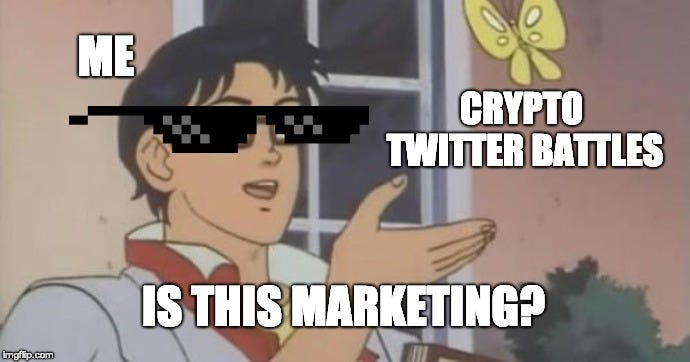
Alongside ecosystem & developer marketing there has been support for API3’s general social, content & creative. Working with our Editorial Lead these processes have been established and iterated, seeing improvements in the external outputs. Early efforts to establish a comms framework has seen more consistency in production quality and a drop in review friction, making for social media communications to be freer flowing. This enables ecosystem activity such as the API3 x Arbitrum Community session to be able to happen.
Beyond this, there is a great deal of work to be done. We need to establish a brand collateral kit to reduce the time for creative requests which will likely require a light creative exploration and then the production of a range of assets. The idea is for this to be in a public kit for all to utilize as needed. Once in situ, this should allow for creative attention on activities such as events or campaigns.
The latter part of the paragraph above illudes to another area we would like to see improvements in during the forthcoming cycle. API3 needs to onboard a marketing manager with a strong campaign mindset that can help our comms become more diverse but also proactive through the introduction of brand, product or user-led campaign structures. With the comms & brand framework in place, this should be a free-flowing process that supports the growth objectives of the BD & Ecosystem functions.
New Blood
We have newcomers to the DAO for whom this will be their very first proposal, let me introduce:
Christina, a familiar in the Web3 and DAO sector. With over three years of hands-on experience, Christina has established herself as a go-to marketing and community specialist within the ever-evolving world of Web3. In her spare time, she’s the driving force behind the burgeoning project, ETHTallinn.
Next, let’s introduce Billy, a crypto veteran who has been deeply involved in the space since 2017. Billy’s passion for innovation led him to working with smart contracts since 2021, and to discovering API3 while on the hunt for an oracle that could support Gnosis Chain. With a primary stack that includes Hardhat/Foundry, Next.js, Wagmi, and Rainbow Kit, Billy has deployed several production projects on multiple chains using QRNG. Beyond his tech accomplishments, he is also a dedicated community manager for the Developer DAO, where he interacts with a variety of protocols and teams. An avid learner, Billy loves participating in hackathons and exploring new tools in his field.
Finally, we have Burooj, a multi-talented professional who has demonstrated impressive capabilities in both creative and development roles. He was instrumental in bringing the Quantumons demo project and other QRNG demo frontends to life. Currently, he’s applying his wide range of skills to the development of a new ecosystem website. His unique ability to blend the creative and technical realms makes him my goto for any creative needs.
We also have Greg and Can moving over from the copywriting and communications proposal respectively. Welcome to the team bois
Ecosystem Budget
| Recipient | Amount | Months | Total | Position |
|---|---|---|---|---|
| Ashar | 9800 | 3 | 29400 | Solutions Lead |
| Ben | 6000 | 3 | 18000 | Ecosystem Growth & Marketing Lead |
| Vansh | 4000 | 3 | 12000 | Developer Relations Engineer |
| Billy | 5500 | 3 | 16500 | Developer Advocate |
| Burooj | 3000 | 3 | 9000 | Front-end developer, creative support |
| Christina | 4200 | 3 | 12600 | Ecosystem and Community Manager |
| Can (pt) | 3000 | 3 | 9000 | Design Support |
| Greg (pt) | 3584 | 3 | 10752 | Editorial & Content Lead |
| Grants Total | 106500 | |||
| Team resources | ||||
| Social media & brand collateral | 15000 | Branded social media kit - creative process with production of brand assets | ||
| Ad-hoc creative | 10000 | Ad-hoc creative requirements | ||
| Ad-hoc developer activity | 10000 | Potential activites with DevDAO, ThirdWeb, AWS etc. Support for EthPrague if needed. | ||
| Contractual Work | 6000 | Development of ecosystem.api3.org and supprt with dAPPs/chain partner projects | ||
| Bunch | 9000 | Community Moderation | ||
| Team Travel & Logisitics | 10000 | Event Travel & Expenses as per additional proposal | ||
| Tooling | 2000 | Team tooling x3 months | ||
| PR | 5000 | |||
| Merch | 2000 | |||
| Overall | 156500 | |||
| 10% flex | 15650 | Marketing hires | ||
| Total | 172150 |
Additionally we want to populate a bounty hot wallet outlined above. Within this proposal we would also like to request 25000 API3 to the wallet outlined below from the API3 Hot Wallet. This is for use within API3 bounty challenges and contributor rewards. We expect this to cover a range of developer-oriented activity such as hackathon bounties, contributor bounties and retrospective bounties for the coming cycle and most likely through to the end of 2023.
